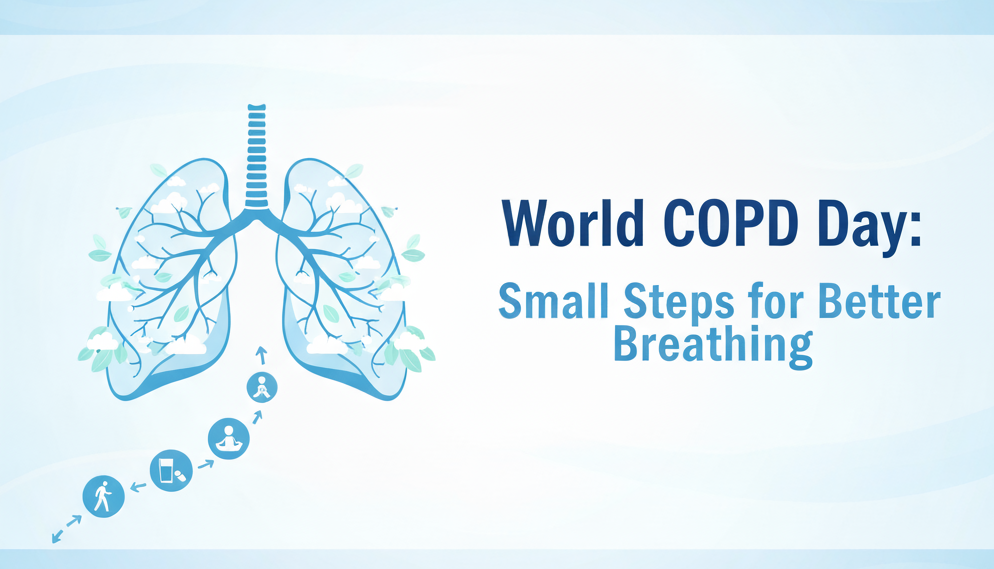We often underestimate the importance of each breath until it becomes challenging. Chronic Obstructive Pulmonary Disease (COPD) affects millions of people worldwide, limiting their ability to live freely and fully. This World COPD Day, let’s talk about what this condition really means, how primary care plays a key role in managing it, and the small, practical steps that can make a big difference in improving lung health.
What Is COPD?
Chronic Obstructive Pulmonary Disease is a long-term lung condition that makes it hard to breathe. It’s typically caused by long-term exposure to irritants like cigarette smoke, air pollution, or workplace chemicals. COPD includes chronic bronchitis and emphysema, both of which damage the airways and reduce airflow to the lungs.
The most concerning part? Many people don’t realize they have COPD until it’s progressed significantly. Recognizing early signs, such as chronic cough, shortness of breath, or wheezing, is key to timely diagnosis and treatment.
Why World COPD Day Matters
World COPD Day, observed every November, aims to raise awareness about lung health and inspire people to take action. The focus is not only on patients living with Chronic Obstructive Pulmonary Disease but also on prevention because early detection and lifestyle changes can significantly improve quality of life.
Understanding the Causes of COPD
While smoking remains the leading cause, Chronic Obstructive Pulmonary Disease can also result from:
- Long-term exposure to secondhand smoke
- Environmental pollution
- Occupational exposure to dust or chemicals
- Genetic factors, such as alpha-1 antitrypsin deficiency
By addressing these causes, individuals can take proactive steps toward protecting their lung health.
Recognizing COPD Symptoms Early
Many dismiss early symptoms as “just getting older” or a mild cold. However, early recognition can prevent severe lung damage. Common symptoms include:
- Persistent cough with mucus
- Shortness of breath during physical activity
- Chest tightness
- Fatigue
- Recurrent respiratory infections
If you’re experiencing these, schedule a check-up with your primary care provider.
The Role of Primary Care in COPD Management
Primary care physicians are often the first line of defense in managing Chronic Obstructive Pulmonary Disease. They help with:
- Regular lung function testing
- Personalized treatment plans
- Lifestyle and medication guidance
- Referrals to specialists when needed
Your doctor can also help identify triggers and design preventive strategies. At DocDx Primary Care Services, comprehensive asthma and COPD management services are available to support long-term respiratory health.
How COPD Differs From Asthma
Though both conditions affect breathing, COPD is typically progressive and caused by long-term lung damage, while asthma often starts earlier in life and can be reversible with treatment. If you experience both, managing triggers becomes even more essential.
Learn more about asthma triggers and how to manage them.
Lifestyle Changes for Better Breathing
Small lifestyle adjustments can help improve breathing and slow COPD progression:
- Quit smoking – The single most important step.
- Stay physically active – Gentle exercises like walking or yoga can strengthen lungs.
- Eat nutrient-rich foods – A balanced diet supports the immune system.
- Avoid pollutants – Use air purifiers and avoid heavily polluted areas.
- Stay hydrated – Helps thin mucus and make breathing easier.
The Importance of Regular Checkups
People with COPD or at risk should have regular visits with their doctor. Preventive exams can help identify changes in lung function early. If you have other chronic conditions, understanding how your annual physical exams differ when you have pre-existing conditions can help ensure you get the most out of your care.
Preventing COPD Flare-Ups
Flare-ups, or sudden worsening of symptoms, can be serious. To prevent them:
- Stick to prescribed medications
- Get vaccinated against flu and pneumonia
- Manage stress effectively
- Keep your home environment clean and free from irritants
Managing COPD in Seniors
Older adults often face additional challenges when living with Chronic Obstructive Pulmonary Disease. They may have other health issues or weaker immune systems. That’s why preventive care is key.
Learn more about how seniors can prevent hospital visits with regular primary care and proactive management.
The Connection Between COPD and Mental Health
Breathing difficulties can take a toll on emotional well-being, leading to anxiety or depression. Support from healthcare professionals, along with mindfulness or counseling, can help patients maintain a positive outlook.
When to See a Doctor
If you experience frequent shortness of breath, unexplained fatigue, or persistent coughing, don’t wait. Early medical intervention can slow disease progression and improve life expectancy.
The Future of COPD Care
New treatments and telehealth options are transforming Chronic Obstructive Pulmonary Disease management. Virtual consultations and remote monitoring can make it easier to manage symptoms, refill prescriptions, and stay connected with healthcare teams, especially for those with mobility limitations.
Taking Small Steps for Better Breathing
Improving lung health doesn’t happen overnight, but small, consistent actions matter. Whether it’s quitting smoking, staying active, or scheduling a regular check-up, these steps can help you breathe easier and live better.
Conclusion
World COPD Day reminds us that lung health deserves attention every day. Through early detection, lifestyle adjustments, and collaboration with primary care providers, Chronic Obstructive Pulmonary Disease doesn’t have to control your life. Start with one small change today; your lungs will thank you tomorrow.




